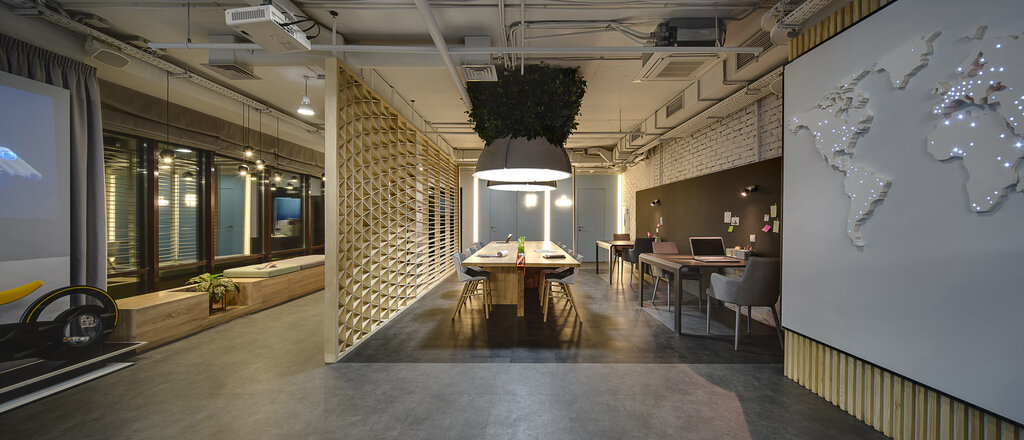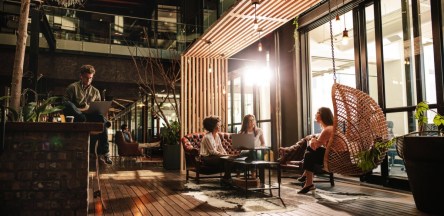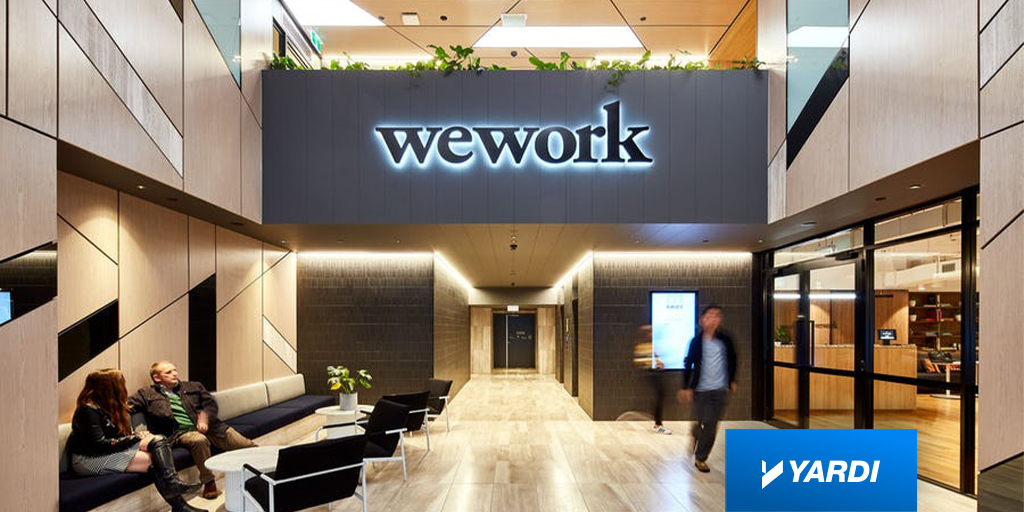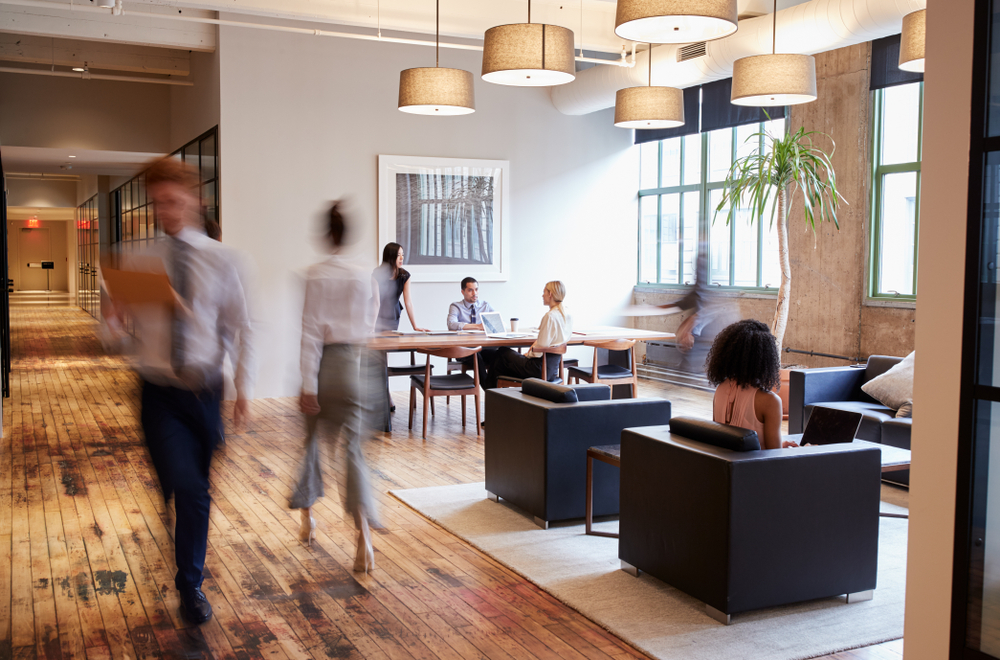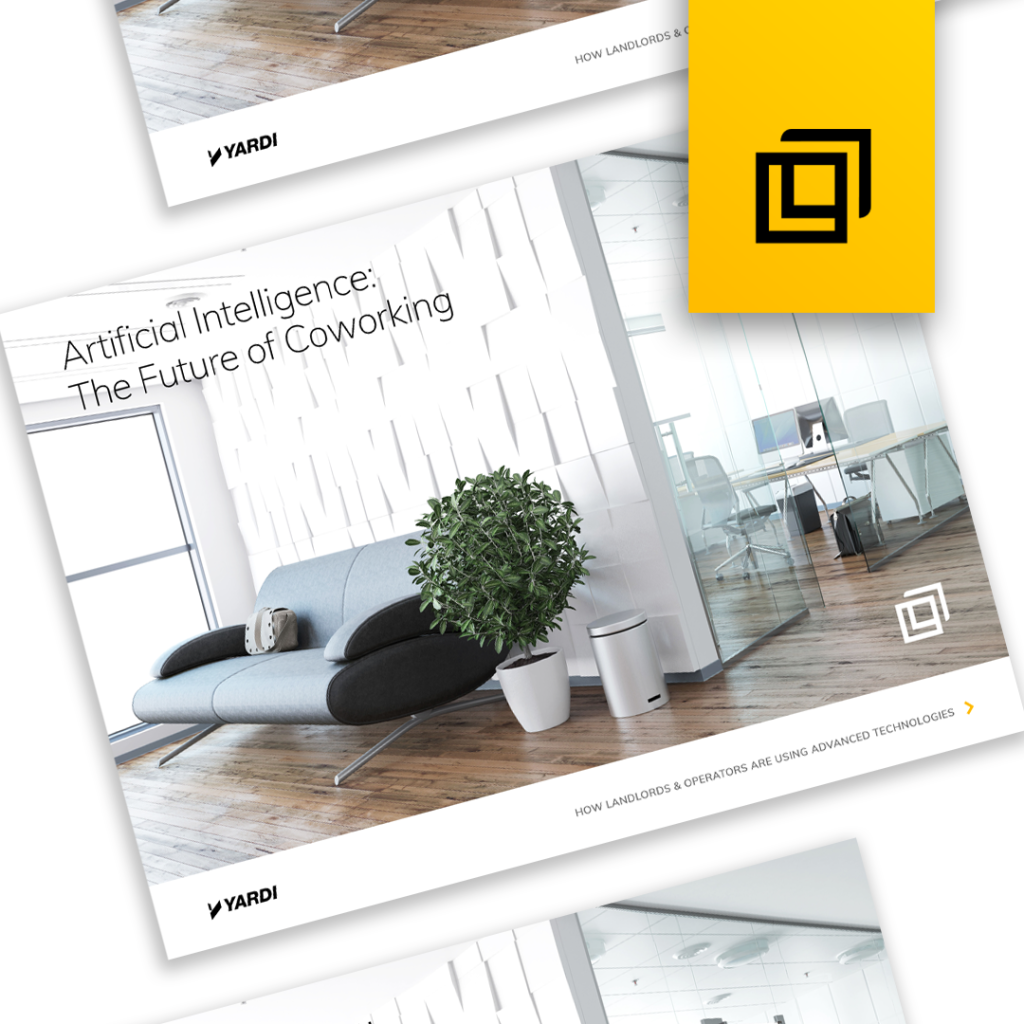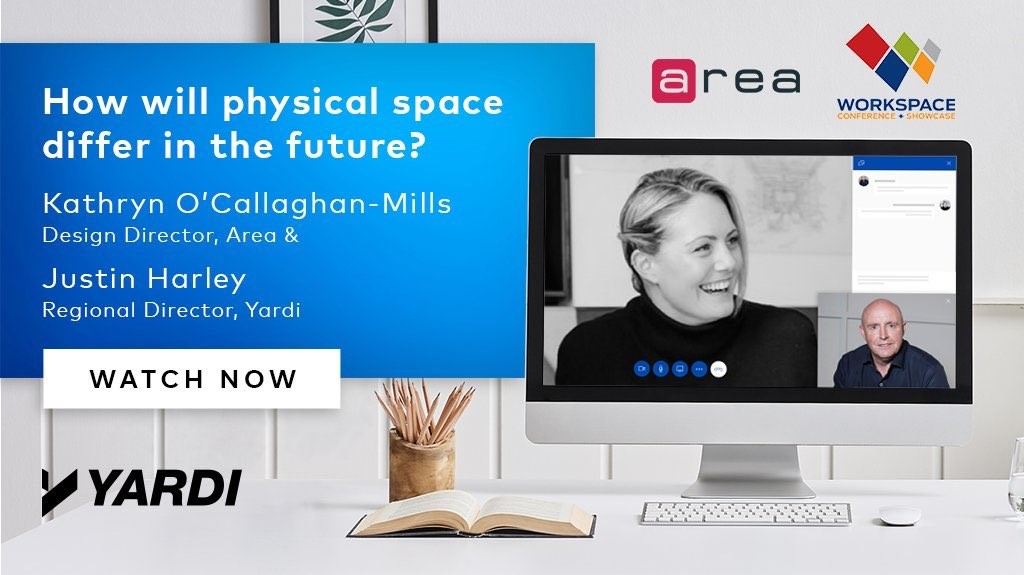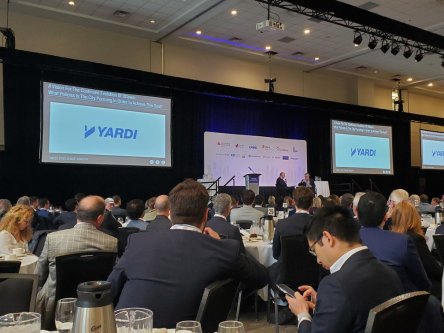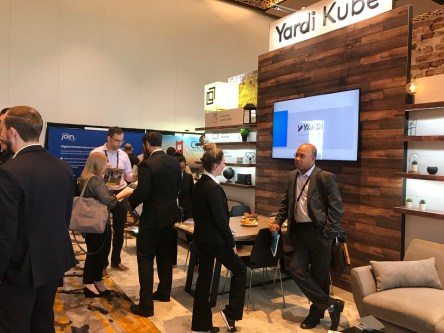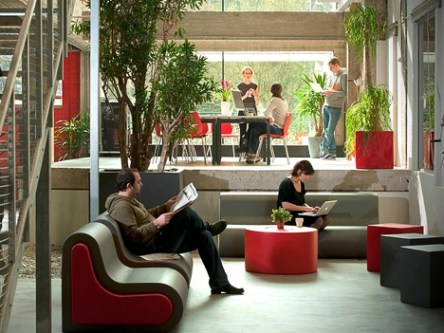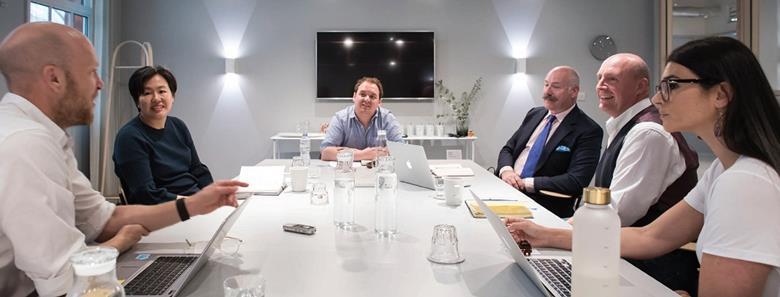Coworking centers are becoming a popular solution for many employees in a new, more flexible world of hybrid, remote, and in-office work. Let’s explore the benefits of a coworking center. Desirability: Coworking centers are attractive to workers. They typically incorporate open space, bright light, modern layouts and an artistic environment. Some even have private rooftop terraces that overlook city skylines. Find several cities worldwide that now have coworking centers. Flexibility: As office workers adapt to new normal, flexibility is the most productive and efficient way to respond to change. Flexible office space is an ideal workplace compromise. Use of a coworking center forgoes the need to hot desk or hotel existing traditional office space – sharable space with needed amenities is already provided, as are collaborative meeting spaces. And since coworking centers are shared spaces, employers can pay monthly without committing to a long lease. Ease of use: Coworking centers will keep up with frequent technology changes. Coworking centers will always have high-speed internet and WiFi. In addition, coworking centers offer video and audio-enabled conference rooms, modern computer systems, improved HVAC systems, member mobile apps for easy bookings, and touchless technology. Some centers may have smart windows to block the outside street noise or can adjust for the lighting needed. Other amenities of coworking centers include parking, electric vehicle charging stations, bike storage, espresso bars, wellness rooms, fitness centers, and event spaces. Some coworking centers are even dog-friendly! Pool tables, dartboards, and ping pong tables are also available in coworking centers for enjoyable mental breaks. Collaboration: Coworking centers offer collaboration opportunities for employers and employees. Working in a virtual work environment, some forms of human contact are lost. When the team can unite in-person, collaborative work and creative ideas are cultivated. The saying “two heads are better than one” is still relevant, especially when working on projects, sales pitches and leads, and event planning. Coming together in a positive space gives the team a chance to brainstorm, collaborate, mentor, and build company culture. Community: Being in a coworking center builds a self-nurturing community among startups, freelancers, creative professionals, and corporate employees who need a focused workspace. The community of coworkers makes the workspace engaging and vibrant, elevating mood and performance. Plus, coworking centers are often located in busy metro areas. Many coworking centers will be found by gyms and restaurants, allowing employees to enjoy city life in conjunction with the coworking experience. Modern offices, equipped with high-end technology, customer-oriented amenities and features, and open space design, will be a requirement if companies decide to pursue a full-scale return to the office. Flexible coworking centers are the ideal compromise: they allow employees to work when and where they feel most comfortable, while preserving the critical benefits of in-person collaboration and...
Creative Coworking
Thinking outside the office
As companies embrace hybrid work, flexible workspaces are becoming a popular solution for many employees. But how can owners and managers of coworking space – which is in major growth mode – raise the bar and make coworking spaces not just attractive, but irresistible? Here are some creative ways to attract workers to coworking spaces. The main advantage of coworking in flexible spaces is typically the open-plan space designs. Gone are the cubicles and assigned desks. Now you can have more room to enable collaboration with team members and other users in the office. But let’s take it up a step further and include a robust coffee and snack bar Include all the fancy fixings for coffee and cold brew, like syrups and creamers. You can include a snack bar with healthy options of various protein bars, fruits, and plant-based snacks. If your budget cannot bring the amenities into the office space, pick a location close to a trendy coffee shop. Think outside the typical Starbucks coffee location and look for a popular local coffee café. Coffee shops that offer a variety of drip coffee, CBD coffee, artisan coffee, and even various teas will be more attractive than just a typical Starbucks or Dunkin Donuts. Another creative way to attract employees to flexible coworking spaces may be to have the office next to a doggie daycare facility. Since the pandemic started, many people have become very close to their fur babies. Leaving Snoopy at home all day alone is traumatizing for both owner and dog. Some doggie daycare facilities may even offer a discount for businesses nearby. Workers can come and have a focused workday, and Snoopy can have a day of play and exercise. You could even take it a step further...
Shared Perspectives
The Buildings Show Panel
Simply providing an open desk isn’t enough for coworking and flexible workspace providers in Canada. What else must space operators do to attract and retain tenants in this dynamic business? That was the topic of a recent panel discussion moderated by Warren Hersowitz, regional sales manager for Yardi Kube. The session at The Buildings Show in Toronto explored ways that space providers can serve members and improve staff efficiency at all stages of the business, from lead generation, IT infrastructure, and space and member management to accounting. Here is a recap of the key points discussed among panelists Christine Andrews, founder of Toronto coworking space provider Acme Works and a founder of Deco Group, a consultancy, and Kane Willmott, cofounder and CEO of iQ Offices, Canada’s largest independent coworking company. Maximize the member experience Creating value in a coworking space requires more than “just good coffee and Wi-Fi,” said Andrews. Settings that are attractive, enable flexible use of furniture and other items and provide opportunities for human connections help operators differentiate their offerings from competitors. “You, and your tenant, will get more out of the spaces when you include the human experience. Only focusing on the space misses an opportunity to charge more per square foot,” added Willmott. He described workspace leasing as shifting from a business-to-business model to business to consumer. Augment the experience with tech With shared space more prominent in the post-pandemic world, technology for managing shared space can make the difference. “Prospective tenants are less inclined to tour the space. That’s where a website that operators can use to post amenities as well as manage leasing and operations management makes a big difference,” Andrews said, adding, “Look for solutions that make it easier for your staff by speeding up the...
WeWork Workplace Launched
Built in partnership with Yardi
WeWork (NYSE: WE), a leading global flexible space provider, today announced the official debut of WeWork Workplace, a new space management solution built in partnership with Yardi, the leading provider of real estate software. WeWork Workplace provides companies with a universal platform that enables inventory management across office spaces, enhanced employee experiences and space optimization through insights and analytics. The proliferation of remote and hybrid work models – vastly accelerated as a result of the pandemic – has created new opportunities for both employers and employees to fundamentally rethink the office and how we engage with it. WeWork Workplace marries space, asset and people management capabilities, removing guesswork from designing a strategic work model by providing actionable data to inform decision making in real time. As a result, the software aims to help employers reduce real estate costs, while empowering employees to more purposefully engage with the spaces they choose and create more meaningful physical connections. WeWork Workplace is the only product in the market that can combine all space types (privately leased/owned, WeWork and WeWork shared/affiliate) within a single experience. Additionally, companies that may need overflow space will have the option to enable access to WeWork and WeWork affiliated locations for their employees globally. “Businesses today must solve for bringing flexible work models to life – optimizing their spaces without sacrificing the culture, collaboration and productivity that happens in-person. This is what we aim to deliver with WeWork Workplace,” said Scott Morey, WeWork’s President of Technology & Innovation. “Combining our advantages in scale, speed and access to flexible spaces, with Yardi’s industry-leading software and tech capabilities, WeWork Workplace doesn’t stop at desk booking or at backend insights – it aims to solve for a dynamic, constantly evolving future of work.” A One-Stop-Shop Solution WeWork Workplace combines the capabilities needed, in one place, to help build, manage and evolve any office space strategy. The software aims to help businesses: Enhance employee experience across an entire portfolio. Dynamic, collaboration focused features built in – interactive floor maps, team booking capabilities, overflow booking automation, visitor management, company announcements and calendar integration, make engagement with the office more intentional and impactful.Manage and optimize all spaces regardless of asset type or geographic location. Universal portfolio management – across all asset types – enables office space strategies centered on utilization. Create user groups, spatial zones and navigate capacity and overflow management. Future proof real estate strategies through actionable insights. Make decisions with confidence through access to stronger, more accurate data. Instantly look into daily and building level data, or view trends over time, such as booking to occupancy ratio, including the ability to sort by property type. Designed to offer a frictionless office experience for companies of all sizes, helping to maximize their spaces for collaboration and innovation, WeWork Workplace is uniquely positioned to enable companies and their people to continuously adapt to a flexible world of work. To learn more about WeWork Workplace, and to sign up for a live demo, visit:...
Meet CoworkingCafe.com
End-to-end coworking solution
The Yardi suite of coworking and flex space tools expands today with the launch of CoworkingCafe.com and the acquisition of CoworkingMag.com. Operators of coworking and flex space can take advantage of Yardi’s market leading lead generation, as well as a new feature to allow real-time bookings for conference rooms and private offices. When combined with Yardi Kube for coworking operations and accounting, Yardi has the very first end-to-end coworking solution for flex operators and owners. CoworkingCafe: For Operators & Occupiers CoworkingCafe.com publishes coworking and flex locations across the country, including real-time availability, amenities and packages, photographs, floor plans and even 360-degree videos. The sleek design offers a seamless experience for researching and booking workspaces, all in one app. From an extensive selection of top coworking brands, users can book and pay for a desk, office, meeting room or a complete office package in just a few clicks. CoworkingCafe.com joins the five existing Yardi commercial listing platforms, CommercialCafe, CommercialSearch, PropertyShark, 42Floors, and Point2, all of which now show coworking availability alongside traditional commercial listings. Together, these sites attract 2 million monthly visits and generate 300,000 high quality leads per year. Coworking operators can now manage inventory, marketing collateral, availability and pricing from a centralized dashboard, while workspaces are marketed across the entire listings network. Yardi Kube clients have the added advantage of managing marketing collateral and availability natively, along with operations, accounting, customer contracts, communications, data and Wi-Fi – a single, connected, end-to-end solution. “With the launch of CoworkingCafe, we are excited to help consumers find and book office space, while helping operators increase revenue,” said Rob Teel, senior vice president at Yardi. CoworkingMag Joins the Team Yardi also announces its recent acquisition of CoworkingMag.com, the go-to source for coworking news and trends. CoworkingMag consistently ranks among the top results for coworking-related searches for locations in the U.S. This addition enhances the power of the Yardi listings network and boosts both visibility and leads for all coworking clients. “The acquisition of CoworkingMag accelerates our efforts with its strong online presence and our Kube clients benefit from an expanded audience for their availabilities,” Teel added. “Together, these products provide unmatched value both to consumers and operators.” The Complete Coworking Platform: Yardi Kube Yardi Kube is the most powerful coworking management software on the market, bringing automation, flexibility, and ease to workspace management. The all-in-one platform handles everything from listing and booking coworking spaces — complete with mobile app — to day-to-day operations management and even automates the sales process from lead generation to proposal and execution. For more information about how CoworkingCafe and Yardi Kube streamline operations and increase revenue, contact us/book a demo...
New Ways to Work
Emerging in 2022
As workers migrate back to their offices, they’ll enter an environment that’s dramatically more accepting of nontraditional working arrangements than before the pandemic. Most industry observers agree that openness to flexible work arrangements among employers will be the norm. A survey by video messaging platform Loom that found that 90% of workers and managers are happier with the increased freedom they now have to work from home. LinkedIn reports that 1 in 67 U.S. jobs offered a remote work option in March 2020; today, that number is about 1 in 7. Here are a few of the trends workers might encounter when – or if – they return to the office: Hybrid here to stay. Harvard Business Review reported in January that more than 90% of employers plan to adopt a hybrid working model in 2022. “In the U.S., employees expect flexibility within their job as much as they expect a 401(k). Employers that don’t offer flexibility will see increased turnover as employees move to roles that offer a value proposition that better aligns with their desires,” according to HBR contributors Brian Kropp and Emily Rose McRae of the Gartner HR Practice. “There’s no one-size-fits-all approach: Experiment with ‘Team Tuesdays’ or in-person office hours between 12 p.m. and 2 p.m., two days a week. Consider quarterly off-sites that bring far-flung teammates together regularly,” suggests Microsoft in its Work Trend Index 2022 survey report.Growth in AI and automation. The World Economic Forum predicts that artificial intelligence and automation will spark the creation of 97 million new jobs by 2025. AI will affect many existing jobs as well, by automating managerial tasks such as approving expense reports and monitoring direct reports’ completion of tasks and letting workers focus on areas requiring creativity, imagination and high-level strategy....
Coworking Trends
Explored at YASC Global
Yardi sought insight into a key office property management trend – flexible workspace arrangements – from a panel of clients at YASC Global. The three panelists, including Yael Urman, chief information officer for New York City-based commercial property developer Silverstein Properties, spelled out why the changing landscape requires greater flexibility. The days of the simple 15-year-lease-and-renew are over, Urman said, having been superseded by demands for work arrangement flexibility that can encompass everything from personalized work area coloring and furnishings to private offices. “We’re in the productivity, flexibility and well-being business now, not just providing four walls,” Urman said. “Our priority now is to offer any option that enables cooperation and enhances productivity for our clients.” Panelist Willie Gutierrez, COO/CFO of Premier Workspaces, an Irvine, Calif., coworking company that owns and leases flex office space, agreed that “it’s the experience, not the four walls” that matters for tenants in today’s office work environment. Gutierrez, whose company’s offerings include offices and conference rooms for as little as an hour, added that private offices for small and medium size businesses is Premier’s most popular offering. The third panelist, Brandon Van Orden, senior vice president and CIO for Atlanta office REIT Cousins Properties, senses a desire among workers to “get back in the office, collaborate in person and enjoy the social aspects of work. They still want big conference rooms for in-person meetings.” Accordingly, Van Orden and his Cousins colleagues describe their offerings as “flexible,” rather than “hybrid,” which implies that some workers remain permanently remote while others are permanently in the office. Cousins is also piloting technologies that create a seamless visitor experience that extends from the parking deck to the building entrance to the office, Van Orden said. Another key trend noted by the panelists...
Safe Coworking
6 Security + Health Tips
Coworking spaces have offered a refuge for displaced employees and freelancers alike. New variants of COVID-19 have many employers teetering between office and remote work environments. More consistently, coworking spaces have provided a way for workers to get work done in a focused environment. As the manager of a coworking space, you’re an unsung hero! The following six steps can help you promote a secure and healthy environment for clients who need your services. Healthy co-working spaces 1. Automate the basics Contactless technology permits simple processes and transactions with less exposure for staff and clients. Automated attendance trackers offer convenient yet controlled access to your shared workspace. Combine Kisi and KUBE door access systems to manage member and visitor logs as well as billing details. Enable pay-as-you-go features that empower any user with a mobile device to begin working automatically. Clients favor the flexibility, and it minimizes cancellations and billing disputes. 2. Improve ventilation and filtration Healthy spaces begin with ample air flow and filtration. Joseph G. Allen, faculty advisor to the Harvard Healthier Building Materials Academy, advises building managers to bring in as much outdoor air as they can to dilute airborne viral particles. If your site has dampers, consider opening them. Recirculated air should be filtered by a MERV13 or higher filter, which capture at least 80% of viral particles. If those standards are unattainable, Allen recommends portable air cleaners with HEPA filters, which capture 99.97% of particles. Enhanced security for transient workspaces 3. Benefit from member education Education is key to risk mitigation. During new member registration, consider hosting an e-learning session that covers the basics of shared workspace security. A few minutes of educational training can drastically improve the security of your coworking space. 4. Offer private Wi-Fi Greater fluctuations in clients may follow...
Café Coworking
Hospitality Bites into Flexspace
Before coworking became an industry, we had coffee shops. Any café with free internet became a place where students and professionals would settle in for work. In the age of coworking spaces, coffee shops are still formidable competition—and tech innovations make the competition stronger. Coffee shops are cashing in as flexible workspaces We’ve all witnessed the coffee shop scene: with a beverage nearby, individuals and small groups hammer out ideas on their laptops or in hushed conversations. Sometimes, we’re one of them. Other times, we vie with them for table space. Coffee shops are the original flexible workspace, and more shops are converting available square footage to fill climbing demand. Awake Coffee Company opened in metro Atlanta in 2015. It was a small, tight space that wasn’t conducive to working. I went twice before finding a different spot. In 2019, Awake moved just one block away to a larger location, and now you can’t keep me out of it. It offers formal and informal coworking quarters alongside its cozy coffee operation. Awake isn’t the only shop cashing in on flexible workspaces. An increasing number of cafes seek a bump in revenue by offering coworking plans. Even restaurants in major metros are getting their cut of the pie. The New York Times reported on the shift, and it continues to gain momentum. New industries blossomed from the shift. KettleSpace and WorkEatPlay both specialize in turning food-focused locales into coworking spaces. Their clients’ clientele are people who don’t want to pay several hundred dollar or more per month for a coworking space. Additionally, they crave a relaxed, social atmosphere. These are freelancers, contractors and gig workers who love what they do because it doesn’t require a designated space. Yes, you can hold your own with the...
Tenant Experience
COVID Has Changed CRE
“Buildings are the next computing platform.” That’s how Chase Garbarino, CEO of HqO, describes the importance of software and building intelligence as companies seek a safe return to the workplace. Just as books shifted to tablets, music switched from CDs to Pandora and Spotify and taxi service switched to Uber, buildings have transformed from manual and analog to newly digital ecosystems. Without a doubt, the pandemic has accelerated the investment into digital infrastructure for companies of all sizes. On a recent CREtech webinar, “State of Tenant Experience: 2021,” host Michael Beckerman, CEO of CREtech, cited an Ernst & Young report that found businesses could save 11% on per-employee costs by switching to a hybrid work model. This is important for the flexible workspace industry, which has been ravaged by the effects of COVID-19 on workers entering offices. As Garbarino stated, coworking put downward pressure on lease length for years, so the traditional office industry had to focus on customer experience and happiness, partly to counter the growth of coworking. That shift to the value of tenant experience now becomes even more noticeable, as there need to be tangible benefits to returning to an office when a vast majority of employees have not lost productivity working at home. On a recent Realcomm webinar, the panel discussed tech advancements to help workers feel more confident returning to the office. Touchless elevators, apps showing office occupancy and desk availability, as well as air quality sensors that can remove pathogens, are just some of the new ways in which employers are trying to safely welcome employees back. But these advances, as reliable and effective as they are, don’t overcome the fact that only 1% of workers are renting a space outside of their homes while working remotely. Based...
Future-proofing Flex Spaces...
Future of Coworking
Better to act than take on the risks of inaction. This was the theme of a recent GWA webinar, in which panelists discussed ways to minimize risk and future-proof a coworking or flexible workspace operation. “The biggest risk is the risk of not doing anything, of not reacting to the market,” said Dan Zakai, co-founder and CEO of Mindspace, a coworking space with locations in Europe and the U.S. By now, we see that the office experience as we knew it is being reimagined. Landlords need to pivot to a hospitality experience in order to safely and effectively welcome tenants and workers back. They need to provide amenities that workers don’t have at home, or offices will see low occupancy given that productivity levels did not drop from the couch, kitchen table or home office. According to Zakai, landlords will raise occupancy levels with coworking faster than with traditional long-term leases. One of the biggest challenges is whether to spend the initial cost on coworking, whether that is building out a new coworking space or transitioning a vacancy. Since landlords typically won’t operate the space, it makes choosing the right partner critical. Giovanni Palavicini, principal at Avison Young, believes one of the keys to success for operators is finding a niche. Much like hotels have seen the growth of boutique offerings, the coworking industry should head in the same direction. This was already a growing trend prior to the pandemic and could accelerate now. Picking the wrong operator with a business model unsuited for your location, or a poor deal structure could create significant risk. “I don’t like RFPs because an RFP allows anyone in the door,” Palavicini said. “Because at the end of the day, we want to figure out who we want...
Returning to the Office
With creativity and technology
The past year has been full of challenges from a traditional office perspective. These challenges have come in a series of phases — initially sending employees home for an indefinite amount of time, implementing physical and tech upgrades to safely welcome workers and guests into offices, creating a potential hybrid working model to accommodate distancing in the workspace and now waiting on sufficient vaccine distribution that will encourage more employees to return to the office. As we look at the progress we’ve made toward re-entering physical workspaces, there is still a great deal of uncertainty as to when occupancy will return to pre-COVID levels. On a recent Realcomm webinar, a group of panelists was asked when they thought their offices would return to some sort of normalcy. Their answers varied: “When we hit 50% occupancy could vary, especially in California with its restrictions,” said Stuart Appley, managing director at CBRE. Appley suggested that around September he believes they could reach 30% capacity in office. CBRE Group is the largest commercial real estate services company in the U.S., and it employs a workforce of more than 100,000. Last fall, the firm formally changed its global headquarters address from California to Texas, where it already has a significant presence, handling property management, leasing and development services for Dallas and Fort Worth office space, as well as other commercial real estate assets. Susan Gerock, CIO and vice president of IT at Washington REIT, says she’s hopeful to be at 50% occupancy “at some point in the fall, but many companies won’t even try to start bringing people back until September.” Joe Rich, senior vice president at Related Companies, and Ilan Zachar, CTO at Carr Properties, both pushed their timelines out a bit further, with Zachar saying his customers believe the end of 2021 will bring some normalcy, while Rich admitted that a return to 100% occupancy is unlikely to happen at all in his opinion. This is a significant cause for debate among industry leaders, because while there is a chance that 100% occupancy is a thing of the past, there is a wide range of guesses as to what working models will look like long term. Once the pandemic is “over” in terms of social restrictions, all signs point to the elimination of a standard 9 a.m. to 5 p.m., Monday to Friday schedule. Whether it’s fewer hours or fewer days in office, employees who have the ability to fully function remotely will do so more often than they did before March 2020. “This trend was occurring before the pandemic, but this just accelerated it,” Rich said. As Zachar mentioned, 25-30% of Carr Properties’ workforce was remote pre-COVID. Many companies were not worried about a drop in productivity when sending employees home, but were concerned about missing out on the tangible benefits to being in an office. Interpersonal relationships and hallway conversations cannot be duplicated on Zoom or Microsoft Teams. In the same manner that the office will lose its appeal, city centers are losing their vibrancy when workers aren’t in the offices. With studies showing that New York City is below 20% office occupancy, Rich expressed concerns about how viable this is for businesses throughout Manhattan and other major hubs. “Our vibrancy is currently at risk,” he said. “We can’t work without public transport.” The concern over mass transit use is one of the principal factors affecting a slow return to physical workspaces. Dallas, Houston, Austin and Philadelphia have all seen significantly higher number of employees returning to office than New York, Chicago and Washington, D.C, the latter three much more dependent on mass transit usage. Leveraging the right technology The panel made a point to differentiate between two unique sets of technology. “COVID tech” are advances such as thermal scanning, virtual conferencing and contact tracing which became necessary due to the pandemic. The second category, tech to encourage people...
Future of Coworking
AI & Internet of Things
One of the most significant trends in coworking and throughout the commercial real estate industry, is the advancement of uses for Artificial Intelligence (AI) and the Internet of Things (IoT). For managers and landlords, it leads to improvements in operational simplicity, features that increase revenue and reduce long-term costs with short-term investment. In our newest eBook, we analyze how AI and the IoT impact shared workspaces today and moving forward. We look at the most prevalent applications of advanced technologies in coworking then examine data on AI implementation and how it has evolved quickly over the past few years. Victor Vasev, Yardi senior director of coworking, explains how the Yardi Kube platform is using AI and IoT to help operators facilitate day-to-day business and adhere to social distancing guidelines for members. Finally, what is next for AI? Our eBook concludes with a look at the next steps for AI in the commercial and coworking sectors. Introduction to AI For the last decade, there has been consistent and rapid growth of coworking which has run parallel to the increase in the uses and potential for AI and IoT. Just about every aspect of our lives – comfort at home, entertainment, energy efficiency, transportation and now social distancing – have been altered by smart technology. The definitions of AI and IoT are intertwined, yet unique. The Internet of Things are internet-enabled devices, connected to collect and share data. Artificial Intelligence means your software gathers data, processes information and analyzes or makes predictions based off that data. In short, IoT is about connection and performing tasks, like requesting that Alexa turn down the temperature on your Nest thermostat. Artificial Intelligence goes beyond what human analysis is capable of to draw conclusions from data, like the Nest itself...
Virtual GWA 2020
Future of Coworking
The 2020 GWA Conference, like many events nationally this year, was forced to pivot to a virtual setting. Despite the quick timeline to put the online event together, GWA was able to gather a fantastic group of presenters and over 1500 attendees took part in the 24-hour production. The prevailing themes were health and safety for both members and staff, as well as the changes the coworking industry can expect to come out of this crisis stronger and smarter. Here is a look at some of the takeaways from the global event. The office is not dead One of the interesting nuances from the pandemic has been how productive employees have been while working from home. Employers have generally been pleased with the productivity of a completely remote workforce. It is potentially a defining moment for coworking spaces, which could reap the benefits of companies who realize they don’t need to house everyone in one centralized location, and many positions could become fully remote. Previously remote workers, on the other hand, may just feel some satisfaction at what they’ve known all along. However, bandwidth limitations, distractions or lack of comfort could pose some challenges while working at home. Joe Brady, CEO Americas of The Instant Group, explained that while work from home policies have had success, coworking solves for the issues that WFH presents. Brady’s stated the 3 C’s for where people choose to work are concentration, community and collaboration. While one may achieve some aspects of that from home or with the emergence of video conferencing, the coworking industry is a hub for all three simultaneously. “The idea of innovation could be dying if everyone is permanently working from home,” he said. “The threads of culture strengthen when people come together.” Ensuring health...
Flexspace Perspectives
New bitesize videos
Yardi is excited to present a series of bitesize insight videos in partnership with Property Week, ahead of Workspace 2020. This series of interviews gathers perspectives from all corners of the flexible workspace industry, reflecting on the uncertain times that we have found ourselves in during recent months. Justin Harley, regional director at Yardi, captured insights from design company Area, flexspace operator Uncommon and data analytics company The Instant Group. In the last of the series, Harley also summarised Yardi’s technology outlook. How will physical space differ in the future post-covid-19? First to take the Zoom stage, was Kathryn O’Callaghan-Mills, Design Director at Area. Harley jumps straight in with the burning question, “how will physical space differ in the future post-Covid-19?” “The beauty of workspace is that it is so flexible, and the key point of our industry is to give the user a flexible experience,” comments O’Callaghan-Mills. “Operators need to consider two main elements; people and space.” O’Callaghan-Mills explains how operators can make an impact by considering these two pertinent points, including enabling social distancing with space management and rotating people within those spaces. Staying true to the bitesize theme, O’Callaghan-Mills promotes a digestible way of thinking with a ‘the now, the next, and the future’ mindset. With ‘the now’ comprising of immediate measures you can take; ‘the next’ acts as a hybrid of the immediate measures and new normal measures; and ‘the future’ which leverages on the innovation and technology investments you make today. How will the landscape of Flexspace change? Harley also spoke to Chris Davies, Director of Uncommon. Davies expressed that “the traditional faceless office is dead.” And how “the real estate industry needs to support the needs, amenities and service demands of flexspace clients.” “Covid-19 has fundamentally changed the landscape – it’s sped up pre-existing trends such as looking after staff. Staff are the most important part of any business and make up 60-80% of most businesses and flexible office space is the corporate enabler.” Davies explained that office users want a healthier workspace and activity-based working – something that the flexspace market has a hold on over traditional office. Davies expressed how corporate companies will continue to absorb the majority of flexspace market. In 2019 40% of occupiers were corporations – Davies only sees this expanding. Companies signing 5-10-year lease agreements will be a thing of the past in Davies’ opinion. “why wouldn’t a business use a better environment for their staff?” How will the demand for flexible workspace differ post-Covid-19? James Rankin, Head of Research for The Instant Group, gave some insightful perspectives on how the demand for flexspace might differ post-Covid-19. Rankin broke his summary down into three main points explaining that demand for corporates will increase, diversification of location of the office portfolio will be prevalent, and the entrepreneurial sector will flourish. Rankin shared insights from a recent research project conducted by Gartner; “Flexspace operators are moving away from the reactionary thought process that Covid-19 has seen them take, and are now moving to make more strategic decisions about the future of flexible workspace. They are looking to reduce costs, make efficiencies and increase the flexibility of their portfolios as a whole.” Diversification of the office portfolio will be ever more important Rankin explained, “we’ve seen a large number of companies look at how they can expand out of large metropolitan, central hubs.” Rankin explained that the supply isn’t there yet in suburban markets. “We’ve seen a spike in interest for flexible workspace. 5 out of our top 13 global coworking markets are now showing interest levels higher than pre-Covid-19. The bounce back is starting to speed up.” Technology Insights & Predictions Last but not least, Harley closed the Bitesize series with a summary of his predictions and insights that Yardi has taken from clients in the industry. “The future of flexible workspace is healthy and positive,” Harley states. Harley...
UKAA Expo 2020
Key Takeaways
It was great to see 400+ people representing the UK’s fast-growing build to rent sector last week at the UKAA Expo 2020; the third event of its kind hosted by The UKAA. Yardi was there in full force with a team of seven passionate residential specialists, all eager to learn, network and engage with the market. Early bird catches the reverse-trade show worm For many, the day started at 10am, but for the exhibitors and operators, it was an earlier start. A conventional tradeshow concept was flipped on its head at The Reverse Tradeshow, giving exhibitors the opportunity to attend 10-minute quickfire meetings with operators. It is great to see companies like EcoWorld, Folio London, Henley Investment Management, PLATFORM_ and Packaged Living investing time into further supporting the growth of the market. Networking and more networking It was all systems go when the doors opened at 10am. The exhibition was home to suppliers from all corners of residential real estate, including PropTech companies, law firms and regulatory organisations. Market Perspectives We were keen to ask other eventgoers how they found the day and get a perspective of their understanding of the market. Justin Harley, Regional Director at Yardi interviewed Lesley Roberts, President of the UKAA and Partner & Executive Director at Allsop, who advised BTR operators to be passionate about customer service, understand the market and find good suppliers. Justin also interviewed Paul Belson, PRS & BTR Investment Consultant who recognised the increase in PropTech innovation and The UKAA’s CEO, Dave Butler, who explained the key to success is to know your customer. Click on each image to watch the full interviews. Session Take-Aways Richard Lankshear, Innovation Manager of NHBC was first to take to stage where he gave some inspiring...
Home, Office
Multifamily + Coworking
Home is where the heart is, as well as the home office for some. All the time at home in front of a computer, however, can lead to feelings of isolation, a lack of inspiration, and a lack of meeting space for collaboration. Remote employees and freelancers turn to coworking spaces for help. To avoid a hectic commute, they seek coworking offices that are as close to home as possible. Herein lies renters’ problem that is an opportunity for multifamily and coworking owners. As the number of digital nomads grows, it outpaces coworking space availability especially in midsize and tertiary markets. Many multifamily communities aren’t equipped with the space, staff, or equipment needed to successfully operate their own coworking space on premises. This is where a collaboration between coworking organizations and multifamily properties can fill the void. Renters want coworking space but providers face challenges The 2020 National Multi-housing Council & Kingsley Apartment Resident Preferences Survey indicates that 46% of renters are interested in coworking space as a community amenity. Additionally, 48% are interested in conference or meeting rooms and 37% take interest in makerspace and DIY rooms. Unfortunately for renters outside of major metropolitan areas, coworking spaces are too far away, face limited availability, or are quite pricey. Some property managers will accommodate renters by creating a coworking space within the community. When space and staff are limited, that simply isn’t an option. For coworking firms outside of major metros, high rents may necessary to stay afloat with inconsistent membership revenues. A reliable base of clients would offer stability and an opportunity for growth but getting such leads is a struggle. Multifamily property and coworking leadership may be able to work together with mutual benefit. Considerations for coworking and multifamily property managers Space...
Onward, Ottawa
Growth + Evolution
Ottawa used to be a city that thrived under the radar. Now, its growth is catching international attention. The 2019 Ottawa Real Estate Forum explored the rapid growth and evolution of the nation’s capital city. This year’s theme, “Ottawa’s on Track: The Hidden Gem of Canada” presented attendees with economic and social forecasts to inform investment decisions. The evolution of Ottawa In 2018, Ottawa was ranked the second most concentrated tech city in North America. With more than 180 tech companies in Ottawa and growing, a smart growth revolution is necessary to attract and retain talent. Yardi sponsored the session “A Vision for the Evolution of Ottawa” with His Worship Jim Watson the Mayor of Ottawa as keynote speaker. Hugh Gorman, CEO of Colonnade Bridgeport, lead a subsequent interview. Watson and Gorman discussed the need of improved efficiencies for policy approvals and repurposed buildings to help municipalities keep up with economic growth. Ottawa has plenty of space to welcome new industries and support existing businesses. At 2,790 km², it is larger than Toronto, Montreal, Vancouver, Calgary and Edmonton combined, the Mayor emphasized. Yet the evolution of Ottawa isn’t solely about new spaces and experiences. Watson encourages the reimagining of existing spaces to enhance usability. Ottawa is also making a name for itself as a center for transportation tech innovations. The city is constructing an autonomous vehicle test track. Ottawa’s vast range of weather conditions make it an excellent training ground for un-manned vehicles. When combined with the $2.1 billion new light rail system Ottawa’s status as transportation innovation center grows. Understanding the retail market Canada’s growth is undeniable. The population of 37 million is estimated to reach nearly 40 million by 2025; since 2016, major cities have created the bulk of the nation’s jobs,...
Shared Space Moving Up
Matrix Special Report
The coworking industry is growing rapidly, encompassing 93.2 million square feet in the top 50 U.S. office markets and making inroads in suburban spaces as well. A new special report from Yardi Matrix portrays a practice that thrives in cities with large technology sectors and in markets with office vacancy rates significantly below the 13.5% national average, including Manhattan, N.Y., San Francisco, Seattle and Boston. Areas with vacancy rates in the high teens, among them Houston and Dallas, have much less coworking space as a percentage of total stock. While 47% of coworking space is concentrated in just six traditional primary commercial real estate markets—New York City, Los Angeles, Washington, D.C., Chicago, Boston and San Francisco—“we expect that coworking will rise in suburban office markets” as the industry matures, the report says. These areas tend to draw clients from home-based workers who want an office for work and socializing purposes and from large corporations that establish small satellite offices. While highly visible turmoil surrounding industry leader WeWork fosters the impression that the entire business model is at risk, “most signs point to coworking as a growth industry that remains in the early stages of development,” the report says. New business models, such as establishing coworking properties in shopping malls and other non-traditional settings, are emerging as well. Get up to speed on all of this dynamic segment’s moving parts, prospects for further growth and risk factors in the new Yardi Matrix special report, “Shared Space: Coworking’s Rapid Growth Set to be...
Coworking Tech Success...
How Us&Co Does It
With shared space workplaces becoming ever more common, it’s important to have the right technology to ensure client success and happiness. Us&Co offers private offices and coworking space in London and Dublin and has a devised a successful model that serves professionals of all kinds. We spoke with Sylvi Wilamowska, head of operations at Us&Co, to find out how on-site tech fits into that experience. An experienced Industry professional, Wilamowska enjoys helping businesses grow and succeed by providing professional workspace they can be proud of, and by taking away the hassle of day to day building management of their own space. Tell us about Us&Co and the company values, mission & objectives? Wilamowska: Us&Co seeks to provide beautifully designed, high-end, professional workspaces, with a variety of uses. We offer our clients space where they can grow and thrive, which is complimented by first class service, delivered by our onsite team and partners. We are strong on design and appeal to a wide variety of businesses. We major on quality furniture, good natural light and space. Whether our clients are from the financial or tech sectors, they expect excellent IT both in the offices and throughout our extensive break out areas. Client satisfaction and therefore retention is our main objective which we achieve through attentive service from our staff and the best systems available. How does Us&Co fit into that? Wilamowska: The market is expanding fast but so is demand. Some markets are becoming overly competitive and some operators are doing unsustainable deals which are creating challenging trading conditions. At Us&Co, we both own and operate our buildings which gives us stability. We want to expand in a measured and controlled way with a long-term horizon. Prior to the relationship with Medusa, what were the...
GWA Highlights
Recap Part 2
After Day 1 of the 2019 GWA Conference, the event continued with conversations surrounding technology, commercial real estate, evolution in workspace design and franchising. Additional conference highlights included: Design evolution This session explored how coworking spaces pair the design of their spaces with marketing and branding for success. Bond Collective strives to create sophisticated, chic spaces with an exclusive club-like atmosphere. No two locations are alike, each geared toward the specific neighborhood they are based in. The spaces are intentionally branded minimally, and designed as symbols of an upscale modern lifestyle. Typically, the spaces feature separate phone and meeting booths for privacy and multiple seating options, such as bars, couches and traditional worktables. Canada’s IQ Office Suites has established unique design differentiators. Following an initial 4,000sf project in Toronto, they have expanded to five locations, soon to be nine, in major Canadian cities. IQ Office Suites’ decisions on where to establish new spaces are based on the surrounding retail, dining and entertainment options on the same street. Window offices are a huge draw, as well as kitchen space, meeting areas, and work/play areas with a bar and event space. Private offices are also important. IQ’s crown jewel is a Toronto space with 18-foot ceilings and a 5,000sf terrace. This location features meeting rooms, team suites, and other group centric areas. The design has moved away from dedicated desks, something many coworking spaces still consider crucial. Winning the corporate occupier One of the final sessions of GWA featured Dale Hersowitz, vice president of coworking for Yardi, as part of a panel discussing how to attract enterprise occupiers. Panelist Jacob Bates, CEO of CommonGrounds, described how technology has essentially made software into a service industry, and this is vital for corporate clients. Hersowitz explained that providing...
2019 GWA Recap
Yardi Kube a Sponsor
The 2019 GWA Conference, held this earlier this month in Washington, D.C., examined the latest trends in coworking. Yardi Kube was once again a platinum sponsor of this well-attended event, demonstrating a commitment to the coworking industry and showcasing new updates to the comprehensive coworking management platform. Let’s recap some of the highlights from conference breakout sessions. (Stay tuned for Part Two of this report, with additional insights.) Positioning your coworking space Led by Kevin Whelan, founder of Everspaces, this session was a discussion about customer purchases and what coworking operators can do to position themselves for quick success. Whelan explained that people, in general, buy on convenience or fidelity. Convenience is the purchase that’s based on how easily you can get something. Price, flexibility, and other ease of access factors play into these decisions. Fidelity is all about the experience. Customers will purchase things they truly love (think iPhones), irrespective of price. These purchases are based on status, visibility, elite design and service. Successful coworking operators must define themselves to attract members looking to purchase based on one of the two categories. For example, NeueHouse prides itself on providing a world class experience in Manhattan, NY and Hollywood, Calif. As a result, their pricing is considered among the highest in the industry. Nevertheless, NeueHouse is very successful. Regus, an industry leader, does not provide a ‘wow’ experience. But the company operates numerous coworking locations in major cities, so ease of access and flexibility when traveling is high. Regus price points are considered affordable. Both NeueHouse and Regus are profitable industry leaders in their own categories. Even niche spaces like The Wing, a women’s only coworking space, also operates a magazine, podcast, and retail store, among other ventures. But The Wing’s owners successfully use...
Shared Workspaces
10 Tips for Multifamily
Looking for a way to increase occupancy without slashing prices? Creative value-add amenities can distinguish your property from competitors. One such value-add feature is a coworking space. The demand for shared work spaces is on the rise. You can benefit from this by transforming an existing area into a coworking space for residents. Coworking Spaces for Multifamily? Nationwide, there are more than 57.3 million freelancers. In corporate America, 55 percent of hiring managers believe telecommuting among full-time employees is becoming a staple in their business structure. That number is expected to rise. Employers responded that nearly 38 percent of their workforce will be telecommuting within the next decade. So where are all of these freelancers and remote employees getting their work done? Their homes and coffee shops, mostly. Fortunately for you, you can be both and attract the revenue for yourself. You can create a shared workspace on your property by converting an existing conference room or business office. Add some chairs and a coffee maker and you’re done! Almost .. here’s the next steps. Must-Have Coworking Space Features Coworking offices are profitable and you can benefit from their popularity and capacity to drive revenue. You will, however, need more than a coffee maker and some chairs to get the most out of the space’s earning potential. Here are five must-haves to make your space functional. High-speed connectivity is a must. You will need to decide whether wi-fi or cable connection is right for your building. Comfortable, customizable seating is just as important as connectivity. Workers must feel comfortable if you want them to return and perceive your workspace as a reason to sign or renew their lease. To increase comfort, equip your space with a combination of adjustable office chairs at desks and...
Coworking Marketing
Strategies and Ideas
As the coworking and shared space industry continues to grow and evolve, it’s becoming much more evident that profitability is not only viable, there are ways to maximize and continue to grow your profits as an operator. Let’s dive into the best coworking marketing strategy for maximum growth. Host Events You’ve likely heard about the potential for fantastic events at coworking spaces. One of the major keys to building your brand is to hold events that are open to the local community. It’s free advertising! People who would otherwise have never stepped foot in your space get firsthand access to all the benefits your space provides. Even if they are not coworking candidates, word of mouth is one of your biggest assets. The more people know about your location, have been inside and can speak to its benefits, the better for you of course. Here are some ideas for events that you could organize within your space: Community panel discussions ‘Breakfast and Learn’ / happy hours Singles’ meetup events Yoga classes Also, keep in mind, if your space does not have 24/7 access, a great way to increase revenue is to host private events after hours. Whether it’s birthday parties, receptions, sporting event watch parties, or just about anything else that you have the room for and would take place past typical working hours. Last year’s Global Coworking Survey revealed that 21% of operators found organizing events to be a top challenge for them, and 50% said attracting new members was a top challenge. These events, whether during or after hours, will solve for a large part of both of those obstacles. Want to learn more about coworking marketing strategies? Check out the rest of this post on the Yardi Kube...
Building a Flexible Brand
Yardi UK Think Tank
New Yardi UK roundtable discussion: With more property companies launching flexible workspace brands, Property Week and Yardi gathered a panel of industry experts to identify the secrets of success in a highly competitive market. Justin Harley (JH) – regional director, coworking, Yardi Maria Cheung (MC) – director and head of interior design, Squire & Partners Giles Fuchs (GF) – chief executive, Office Space in Town Alessa McNally (AM) – head of member’s experience, The Office Group John Williams (JW) – head of marketing, The Instant Group Simon Creasey (SC) – (moderator) contributing editor/features, Property Week What are the key components needed to create a successful flexible workspace brand? GF: Location, design, building layout, staff, culture, ethos, IT, consistency of customer service. You can go on forever making a list, but all of those things need to be a part of it. AM: Location is absolutely key. It’s definitely at the top of the list of things we look for when opening up a space. Also member experience. We are here to create a memorable experience for our members. JW: I agree, it’s all about the member experience. The conventional real estate market is still referring to the ‘occupier’ or the ‘tenant’. They’re thinking about looking after an asset and not providing an experience, which is what flexible workspace providers do so well. Once people experience the flexible workspace market I think it’s a shock when they go back to conventional office space because the level of service just isn’t there. What makes a great location for a flexible workspace centre? GF: We previously had a company that covered the whole of the UK and when we opened a property outside London one of my metrics was it had to be five minutes -walk from a Marks & Spencer. In London, our MO is that the location has to be within a four-minute walk – five minutes is probably okay – of a tube or rail hub. JW: I said two years ago that we were going to start to see the rise of second cities and coworking and flexible space becoming a story in the regions and I’m glad to say I was right. Demand for flexible workspace in cities like Bristol, Birmingham and Manchester is increasing by 25% to 30% every single year at the moment. Those secondary cities in the UK are really flying and we’re also seeing that in Europe and in the States. How important is design and fit-out to a flexible workspace brand? MC: It’s become massively important. It should have always been massively important, but the standards have been raised and everyone is really enjoying and realising the benefit of great design in the workspace. It’s no longer about sitting at a fixed desk. We are working in different ways. People want to be able to sit, to stand, to walk around and look at things. Design can enhance and allow different ways of working through the use of things like natural light, biophilia, control of the environment and even acoustics. JH: One of my favourite spaces in London is [flexible workspace provider] Uncommon. They have a lot of biophilia, but it’s the scent in their buildings that’s really beautiful. Smell is one of the most important senses. JW: I think there is a perception of how coworking and flexible space should look; it’s a bit like coworking design bingo. There should be exposed brickwork, free beer, lots of dogs and avocados on tap, but that’s not the case. There is a real individuality of different approaches and different spaces being provided. In the flexible workspace and coworking sector the word ‘community’ pops up time and time again. How important is it to create a sense of community in your flexible workspace? MC: When we created The Ministry [The Ministry of Sound’s private members club and coworking space] we worked closely with them...

